ROCKET TANKS, or How to instill foreign design in armor
In the postwar years ATGMs appeared in many countries of the world. To increase mobility, they began to install them on cars and armored wheeled vehicles. Naturally, the question arose about weapons tanks guided anti-tank shells (now abbreviated as ATGM).
For the first time abroad, guided projectiles (hereinafter, they will be called a TOURS - tank guided projectile) were installed on the French light tank AMX-13 in 1959-60. These tanks were armed with the SS-11 TOURS in two versions; two launchers on the turret roof or 4 launchers on the front wall of the turret.
In 1959-60 The United States purchased several thousand SS-11 and SS-10 anti-tank guided missiles in France. There were attempts to install these projectiles on M-48 and M-60 tanks, but this didn’t go further than the prototypes, although the SS-10 and SS-11 pierced any armor of any Soviet tank (at least until 1965).
Anti-tank shells of the first. generations (including SS-10 and SS-11) had manual control by wire. The operator had to direct them with a special pen to the target. Low pointing accuracy and long flight time eliminated shooting from the course. The manual projectile launching system led to the formation of a large, innocent area (500-600 m). The open location of the beam-type launchers on the tank’s armor made it impossible to reload the launcher under enemy fire. The shells themselves were exposed to bullets and shrapnel, not to mention nuclear explosions.
At the beginning of the 70-s in the United States were adopted nv weapons of the new generation of "Shilleyla". The new TOURS was guided semi-automatically by the infrared beam. Shilleyla was launched from an 152-mm tank gun, which, in addition to the rocket, fired conventional high-explosive and cumulative shells. The Americans have equipped Shillejlaks with 1500 light tanks МХNUMX Sheridan and 551 medium tanks М540А60. The M2 ammunition consisted of 551 TOURS and 10 conventional shells, and the M20A60 included 2 TOURS and 13 conventional shells.
However, in the middle of the 70-s, the production of tanks with the Shilleyla Tours was discontinued due to the high cost and unsatisfactory effectiveness of the Tours, as well as the weaker action of 152-mm short cannon shells compared to 105- and 120-mm tank guns.
Attempts by Western designers to create a TURS that could be used to shoot 105- and 120-mm regular tank guns proved unsuccessful. Prototypes of such a TOURS had a weak cumulative effect and a number of other shortcomings.
Thus, in the NATO countries, the tank cannon is still the only gun of the tank, although at the beginning of the 80-s, Western experts recognized that at distances over 2-2,5 km, conventional shells of tank guns are less effective than guided shells.
The development of tank missile weapons in the USSR went completely differently.
In 1957, in connection with the development of anti-tank guided missiles and a change in leadership’s views on the role of missiles weapons in tanks. Works were carried out in three directions:
a) the use of infantry ATGM as an additional armament of tanks;
b) the creation of guided tank armament systems;
c) the creation of special tank destroyers.
As a result of the work in the first direction in 1963, a number of T-54, T-55, T-62, T-10М and PT-76B tanks additionally equipped the Malyutka 9K14 ATGM. In addition, the construction of PU "Baby" was installed on an experimental tank of about. 167, created in 1961 on the basis of T-62. The built-in launcher (on PT-76B - twin) was located outside the rear of the tower in special housings. Targeting missiles at the target was carried out with the help of a regular tank sight.
In 1957, the design of the first Dragon complex, 2K4, began. The head developer of the complex was assigned to KBER-1 GKRE (State Committee for Radio Electronics). The projectile was occupied by KB-1 and TsKB-14, the chassis was made by plant No. 183 (Uralvagonzavod), and the sighting devices were done by TsKB-393 (TsKB KMZ).
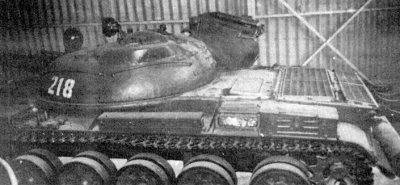
Experienced tank object 167 with ATGM "Baby"
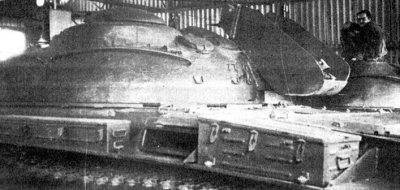
Container for vocational schools PC "Baby" on the tower of the tank ob.167
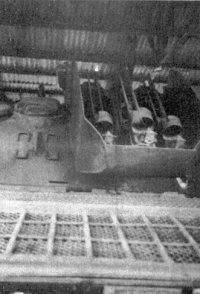
Accommodation ATGM "Baby" in a container
The complex had a semi-automatic guidance system with the transmission of commands over the radio beam. "Dragon" was designed for a special tank IT-1 (IT is a tank destroyer) (150 object), which was developed at Uralvagonzavod with 1958 under the guidance of L.N. Kartseva. The tank did not have a cannon and was armed only with a “Dragon” launcher. Ammunition of 15 missiles ZM7 was placed under the armor of the tank. Of these, 12 was placed in an automated piling, which carried the projectiles moving and feeding to the launcher.
In April of 1964, two experienced IT 1s were transferred to joint tests. Until the end of 1964, the 94 controlled "Dragon" was launched.
By the Resolution of the Council of Ministers of the USSR No. 703-261 from 3.09.1968, the Dragon complex was adopted and produced in small series from 1968 to 1970. So, for example, in 1970, the Izhevsk plant produced 2000 missiles ZM7, and Uralvagonzavod - 20 machines IT 1.
During testing and operation, the complex showed high reliability (up to 96,7%), but its design flaws (large dimensions, weight of control equipment in the tank was 520 kg, outdated element base, large dead zone, etc.) and the absence of a gun on the tank caused the removal of IT 1 from production.
Interestingly, the already mentioned Resolution No. 703-261 stated:
"To work out in 1968 the question of the expediency of transferring the Dragon missiles to the T-64А base while simultaneously improving the characteristics of the weapons." But the "study" showed that these works can be completed no earlier than 1972, when he can no longer compete with promising TOURS.
The next set of TOURS was "Lotos", the development of which was started at TsKB-14 (KBP) in 1959. It had a semi-automatic guidance system and transmission of commands via the infrared beam. The control system was developed by TsKB KMZ. The developers believed that the Lotus guidance system would be more noise-proof than the radio-controlled system. The Lotus launcher had beam-type guides.
TOURS "Lotos" was supposed to be installed on a new heavy tank designed by CTZ. But Resolution of the SM number 141-58 from 17.02.1961, the development of this heavy tank was discontinued. Only a mock-up of a heavy tank was made on which factory tests of Lotos missiles were carried out in 1962. In the spring of 1964, the Lotos complex, installed on the BTR-60P, was tested at the Gorokhovetsky testing ground. Missiles were launched in both fixed and moving infrared rays. In addition, the design of the installation of the Lotus on the T-64 tank (432 object) was developed. Nevertheless, the complex was not accepted for service. Total costs on the subject amounted to 17,5 million (those) rubles.
In 1961, the development of the Typhoon TOURS (factory index 301П) began. The head developer of Typhoon was OKB-16. The control system in "Typhoon" was made manually, the transmission of commands was carried out over the radio beam. The 9М15 projectile was equipped with a cumulative fragmentation warhead. Moreover, the fragmentation effect of 9М15 was equivalent to the action of X-NUMX-mm grenades from the D-100 cannon, which were armed with T-10 and T-54. Launcher beam type.
The Kirovsky Design Bureau, under the leadership of J. Y. Kotin, created a reckless missile tank ob.287, which had a double reservation. The body of the tank is welded, armor combined, consists of 90-mm armor, then comes 130 mm fiberglass sheet, then again 30 mm armor and 15 mm special anti-radiation podboi. The armor of the tank was not pierced by either subscale or cumulative shells of any tank guns that were then in service, the crew of two people was in the control compartment in a special armored capsule and was sealed off from the crew compartment.
The tank’s armament consisted of a Typhoon TURS launcher, two 73А2 “Lightning” 25 guns and two machine guns paired with guns.
Instead of a tower on the roof of the case, a rotating platform was installed, in the center of which there was a hatch for a retractable launcher. PU was stabilized in a vertical plane, which allowed the Typhoon to fire on the move at a speed of 20-30 km / h.
To the left and right of the hatch, two armored caps were welded to the platform, each with a 73-mm cannon and a machine gun. In the guns "Lightning" used ammunition from the gun 2А28 "Thunder" installed on the BMP-1.
The lightning gun as a loading mechanism had two drums of a revolving type of 8 shots in each. All armament was controlled remotely.
Two tanks about 287 in April 1964 were entered for factory tests at the Gorokhovetsky landfill. Of the 45 controlled starts, there are 16 target hits, 18 failures, 8 misses and 3 uncalled starts. Each tank passed at least 700 km. By the end of 1964, the tests were stopped to eliminate the identified deficiencies (the unreliability of the missile control system, the unsatisfactory effect of firing 2A25 cannons, etc.). Later work on the "Typhoon" and completely stopped.
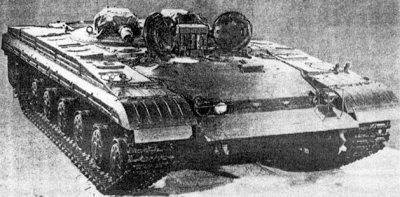
By a decree of the USSR Council of Ministers on 30.03.1963, work began on the creation of a tank of the 775 and two Astra and Rubin missile systems. At the technical project stage it was supposed to choose the best of them.
The missiles of both complexes were supposed to have supersonic flight speeds twice as high as the “Baby”, “Dragon”, “Lotus” and others. These were the first TOURS fired from a tank gun (PU).
The main developer of Astra was OKB-16, and the radio equipment of the control system was designed by OKB-668. By the decision of the section of the NTS of the State Committee on Defense Technology from 1.03.1964, Rubin was chosen from the two complexes, and the work on Astra was stopped. By that time, the Astra had spent 601 thousand rubles.
The SKB (later KBM in the city of Kolomna) was appointed the head developer of the Rubin complex.
“Rubin” had a semi-automatic guidance system with the transmission of commands over the radio beam. The complex was designed for a special missile tank "ob.775".
In 1962-64 In the SKB-75 (Chelyabinsk Tractor Plant), under the leadership of P. P. Isakov, a missile tank was created on 775. The OKB-9 created for it a barrel rifled (32 rifling) D-126 launcher of 125 mm caliber firing the "Typhoon" TOURS and unguided high-explosive fragmentation projectiles "Bour". The maximum range of shooting "Drills" - 9 km. The launcher had an automatic loader and was remotely controlled by the commander-operator. D-126 was stabilized in two planes by the 2-16 stabilizer.
The diesel power unit and transmission obn. 775 were borrowed from the T-64 tank, but the experienced tank (775T object) had a gas intake unit with two GTE-350 engines.
Hydropneumatic suspension allowed for a step change in the clearance of the machine.
Both crew members were placed in an isolated cabin inside the tower. The driver was located to the right of the launcher on a movable seat. He led the observation through the viewing instruments of his rotating turret, which was held in place during the rotation of the tower by special mechanisms. In this case, the driver and his viewing device remained constantly directed along the longitudinal axis of the hull, which ensured continuous monitoring of the road.
Tank obn.775 was not adopted due to the fact that the crew did not see the battlefield, the complexity of the device and the low reliability of the guidance system of the Tours.
On the base of the 775, a tank of the 780 was also developed, with a crew of three in the turret, with the driver in the cockpit along the axis of rotation of the turret. When turning the tower, it rotated around this cabin. The 125-mm rifled gun could shoot both the Tours and conventional artillery shells.
Since the beginning of 1964, ballistic launches of Rubin missiles have been made, and at the end of the year, guided launches.
Due to the fact that the tank Obn.775 was not put into service, the option of installing the Rubin into the T-64 tank (Obn.432) was being worked out. But it turned out that the placement of the Rubin control equipment, which occupied the volume of 200 dm3 with weight in 180 kg, in the tank body is possible only in the driver’s compartment, in place of 7 cannon shells and the fuel tank on 150 l. In addition, the half-meter "Rubin" projectile did not fit in the T-64 and required upgrading in a separate version: the 820 mm propulsion system and the warhead with the 680 mm equipment compartment. In the end, the installation of "Rubin" in the T-64 considered inappropriate, and work on the topic were closed.
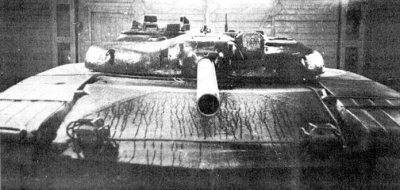
Missile tank about. Xnumx
“Ruby” was the last first-generation TOURS, but before moving on to modern-day TOURS, let's say a few words about an unusual and unprecedented tank missile system.
In 1968, the design and development of the Taran and Rosehip tactical missile systems began in KBP. Both complexes were supposed to have a single rocket, but placed on different chassis - the “Taran” was intended for tank regiments and mounted on a tank, and the “Rosehip” was for motorized rifle regiments and, accordingly, mounted on the BMP-1 base.
The rocket was worked out in two versions: as NURS and with a simplified correction scheme. The rocket engine was solid fuel, and the warhead was designed only special.
Initially, the "Taran" was planned to be installed on a tank of type ob.287.
Then the T-XNUMHA tank was chosen as a chassis. Its main advantage was the round-up fire and the ability to fire a TURS from a universal launch vehicle. For the T-64A tank, the Taran-64 Tours was designed, which is similar in weight and dimensions to the Taran missile. "Taran-1" should have a fragmentation-cumulative warhead and a homing head, the launch was carried out using an optical sight, i.e. The principle of "shot and forget" was implemented.
Thus, the T-64A tank with the Taran complex could deliver powerful strikes with special charges on enemy tank and motorized rifle units. And then - to produce the surviving armored vehicles of the TURS-Taran-1 armored vehicles, being outside the zone of destruction of the enemy’s tank guns and anti-tank guided missiles.
However, by the beginning of 1972, work on the "Ram" and "Dogrose" had been stopped, which was probably due to political reasons. Technically, the project could well be implemented.
So, neither "Typhoon" from ob.287, nor "Ruby" from ob.775 were adopted. Here, like the Americans with the Shill-Melay, the designers took the path of significantly reducing the ballistic qualities of the tank gun, which sharply reduced the combat capabilities of the tank. It turned out that the Tours cannot replace a tank gun and is only good as an addition to it, and that if its installation does not degrade these guns.
In fact, the Tours is not suitable for firing at infantry, field artillery, mortars, etc., at any objects near the tank ("dead zone") and at a distance of more than 4-5 km. A TURS is ineffective when firing at a tank in a trench or a bunker because of the possibility of dropping a projectile into the ground or into a trench parapet due to the fact that the ATGM oscillates in flight in a vertical plane.
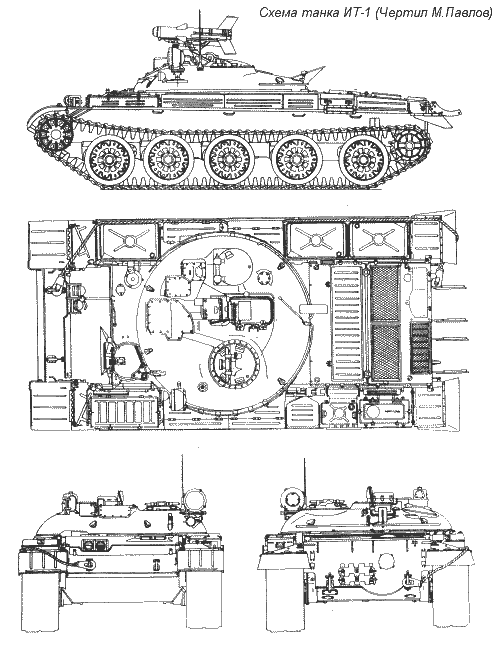
Scheme of the tank IT 1 (drew M. Pavlov)
Guided Projectile 9М112М
1 - warhead; 2 - marching engine; 3 - throwing device; 4 - pallet; 5 - tail section; 6 - hardware compartment; 7 - head compartment
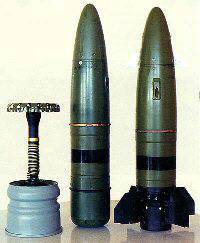
Shot with guided projectile 9М119. 125-mm caliber for T-72B, T-80 tanks
In general, the appearance of the Tours did not shake the winged formula of the designer Grabin: "Tank is a wagon for a cannon."
The next-generation TOURS have become simply guided shells of tank guns, not differing in size or appearance from cumulative or high-explosive fragmentation shells. Like conventional projectiles, TURS for 100-mm and 115-mm guns had a unitary, and for 125-mm guns - separate-sleeve loading.
20 in May 1968. The Resolution of the Council of Ministers of the USSR on the start of designing a new generation of turmeric was issued. The Resolution provided for the competitive design of the Gyurza and Cobra Tours. Both rockets had the weight and size characteristics of the 125-mm high-explosive fragmentation projectile D-81 and separate loading.
The development of "Gyurzy" was conducted in KBM under the leadership of the chief designer S.P. Invincible.
A semi-automatic control system with an infrared communication line was created by a branch of the Central Research Institute of Automation and Hydraulics of the Ministry of Defense.
But the Krasnogorsk Mechanical Plant strongly delayed the manufacture of the “sight-daynumber-tracking device”, created on the basis of the “Frame-1” sight-rangefinder. As a result, Cobra significantly overtook Gürzu and 14 in January of 1971. Gürze’s work was discontinued, and part of the plant was used in the design of the Sturm complex.
The Sturm complex had a semi-automatic targeting system — the breeder only kept the sight mark on the target, and the control system automatically led the missile to it. The control commands were transmitted over a narrow radio beam. The 1AZ control system included a range-finder 1-X42, a ballistic computer 1-X517, and other equipment.
The shell consists of two compartments, stacked in a tank, head and tail, connected to each other in the trays of the loading mechanism and in the process of moving the projectile into the cannon.
Two T-64A tanks were allocated for testing the Cobra Tournament, the first of which arrived at the Gorokhovetsky test site 23.02. 1971 d. During the factory tests of the Cobra Tours, increased sight vibration was noted, preventing firing on the move, insufficient reliability of the loading mechanism, etc. Subsequently, most of the shortcomings were eliminated.
In 1976, the T-64B tank with the Cobra was adopted.
In 1985, a T-72B tank armed with an 125-mm smooth-bore tank gun 2А46М that fired 9М119 rocket of the Svir complex was put into service. The principal difference between "Svir" and "Cobra" was the noise-proof semi-automatic rocket control system using a laser beam.
Almost at the same time, the T-80U Reflex complex, which has the same XVUMXX9 missile as the Svir, is put into service. Differ complexes management system.
To increase the combat power of old tanks in 1983-1985. The 9K116 "Bastion" and 9K116-1 "Sheksna" complexes, created in KBP, are being put into service. Both complexes have the unified 9М117 rocket and almost identical semi-automatic control systems. Commands are transmitted by laser beam.
Complex "Sheksna" was set on the T-62M armed 115-mm smoothbore guns U5-TS, and the complex "Bastion" - in tanks T-55M and T 55AM armed 100-mm rifled gun D-10TS-2. In addition, in the autumn of 1986, the Bastion-K complex passed state ship tests on a small artillery ship of the 1208.1 Ave. and was recommended for use.
Thus, it took almost a quarter of a century to instill in the tanks at first an alien construction — guided anti-tank shells. In the creation of a TOURS, the priority of domestic structures, which still have no analogues in the world, is indisputable. The rapid development of computing and laser technology creates the prospect of the emergence of a fundamentally new Tours, in particular, the implementation of the principle - "fired and forgotten."

Information